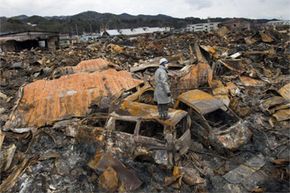Nuclear Catastrophe and Reactor Shutdown
Remember, at the heart of every nuclear reactor is a controlled environment of radioactivity and induced fission. When this environment spins out of control, the results can be catastrophic.
For many years, the Chernobyl disaster stood as a prime worst-case example of nuclear malfunction. In 1986, the Ukrainian nuclear reactor exploded, spewing 50 tons (45 metric tons) of radioactive material into the surrounding area, contaminating millions of acres of forest. The disaster forced relocation of 150,000 people, and eventually caused thousands to die from cancer and other illnesses [source: History.com].
Advertisement
Chernobyl was poorly designed and improperly operated. The plant required constant human attention to keep the reactor from malfunctioning. Yet even a well-designed nuclear power plant is susceptible to natural disaster.
On Friday, March 11, 2011, Japan experienced the largest earthquake in modern history. A programmed response at the country's Fukushima-Daiichi nuclear facility immediately descended on all of the reactor's control rods, shutting down all fission reactions within 10 minutes. Unfortunately, however, you can't shut down all radioactivity with the flip of a switch.
As we explored on the previous page, nuclear waste continues to generate heat years after its initial run in a power plant. Similarly, within the first few hours after a nuclear reactor shuts down, it continues to generate heat from the decay process.
The March 2011, quake manifested a deadly tsunami, which destroyed the backup diesel generators that powered the water coolant pumps the facility had turned to after it couldn't get power from Japan's grid. These pumps circulate water through the reactor to remove decay heat. Uncirculated, both the water temperature and water pressure inside the reactor continued to rise. Furthermore, the reactor radiation began to split the water into oxygen and volatile hydrogen. The resulting hydrogen explosions breached the reactor building's steel containment panels [source: World-Nuclear.org].
Simply put, the Fukushima-Daiichi facility had many countermeasures in place to shut down operations in the event of severe seismic activity. They just didn't count on losing power to their coolant pumps.
Plants such as Japan's Fukushima-Daiichi facility, Russia's Chernobyl and the United States' Three Mile Island remain a black eye for the nuclear power industry, often overshadowing some of the environmental advantages the technology has to offer.
Related Articles
More Great Links
Sources
- BBC News. "Guide to UK Nuclear Power." BBC News. (Aug. 22, 2008) http://news.bbc.co.uk/2/shared/spl/hi/guides/456900/456932/html/default.stm
- Government Accountability Office. "Disposal of High-Level Nuclear Waste." Gao.gov. (July 14, 2018) https://www.gao.gov/key_issues/disposal_of_highlevel_nuclear_waste/issue_summary#t=0
- History Channel Web site. "Life After People: Chernobyl." 2008. (Aug. 21, 2008) http://www.history.com/minisite.do?content_type=Minisite_Generic& content_type_id=57785&display_order=6&mini_id=57517
- History.com. "1986: Nuclear explosion at Chernobyl." History.com. (July 14, 2018) https://www.history.com/this-day-in-history/nuclear-explosion-at-chernobyl
- Hvistendahl, Mara. "Coal ash is more radioactive than nuclear waste." Scientific American. Dec. 13, 2007. (Aug. 27, 2008) http://www.sciam.com/article.cfm?id=coal-ash-is-more-radioactive-than-nuclear-waste
- Lenzen, Manfred. "Is nuclear power zero-emission? No, but it isn't high-emission either."
- Minnesota State University Mankato. "Engaged in Thermodynamics: Steam Turbine Power Plants." Mnsu,edu. (July 14, 2018) http://bit.ly/2LfOEEp
- National Public Radio. "Japan Struggles For Stability In Quake's Aftermath." Npr.org. March 15, 2011. (July 14, 2018) https://n.pr/2Lh09M5
- Nosowitz, Dan. "How Nuclear Reactors Work, And How They Fail." Popular Science. March 14, 2011. (July 14, 2018) http://bit.ly/2LfWQrs
- Nuclear Energy Institute (NEI). "Nuclear Waste: Amounts and On-site Storage." 2008. (Aug. 27, 2008) http://www.nei.org/resourcesandstats/nuclear_statistics/ nuclearwasteamountsandonsitestorage/
- Nuclear Energy Institute. "How Is Nuclear Energy Used to Produce Electricity?" Nei.org. (July 14, 2018) http://bit.ly/2LhYiGI
- Nuclear Energy Institute (NEI). "Resources & Stats." 2008. (Aug. 15, 2008) http://www.nei.org/resourcesandstats/
- Nuclear-power.net. "Containment Building." Nuclear-power.net. (July 14, 2018) https://www.nuclear-power.net/nuclear-power-plant/containment-building/
- Nuclear Regulatory Commission. "Low-level waste." Nrc.gov. Aug. 3, 2017. (July 14, 2018) https://www.nrc.gov/waste/low-level-waste.html
- Salisbury, David F. "A Chernobyl in the US? Not too likely, say scientists. Reactor containment buildings and US design reduce the risk." Christian Science Monitor. May 5, 1986. (July 14, 2018) https://www.csmonitor.com/1986/0505/areact.html
- Union of Concerned Scientists. "How Nuclear Power Works." Ucsusa.org. Jan. 29, 2014. (July 14, 2018) http://bit.ly/2LbY72R
- U.S Energy Administration. "Frequently Asked Questions." Eia.gov. Aug. 15, 2017. (July 14, 2018) http://bit.ly/2Jnu3MB
- U.S Energy Administration. "What is U.S. electricity generation by energy source?" Eia.org. March 7, 2018. (July 14, 2018) http://bit.ly/2LhWNZ6
- Wald, Matthew. "Threats and Responses: Reactor Vulnerability." New York Times. Sept. 20, 2002. (July 14, 2018) https://nyti.ms/2Ld9VC3
- World Nuclear Association. "Nuclear Power in the World Today." World-nuclear.org. April 2018. (July 14, 2018) http://bit.ly/2JmIUHo
- World Nuclear Association. "Nuclear Power Reactors." World-nuclear.org. January 2018. (July 14, 2018) http://www.world-nuclear.org/information-library/nuclear-fuel-cycle/nuclear-power-reactors/nuclear-power-reactors.aspx
- World Nuclear Association. "Physics of Uranium and Nuclear Energy." World-nuclear.org. February 2018. (July 14, 2018) http://bit.ly/2LjATF0
- World Nuclear Association. "Plutonium." World-nuclear.org. October 2017. (July 14, 2018) http://bit.ly/2LaaHQk
- World Nuclear Association. "What is Uranium? How Does it Work?" World-nuclear.org. January 2017. (July 14, 2018) http://bit.ly/2Lf0ZsI
- Zielinski, Sarah. "What Is Enriched Uranium?" Smithsonian.com. Jan. 10, 2012. (July 14, 2018) http://bit.ly/2L9i7Dj
